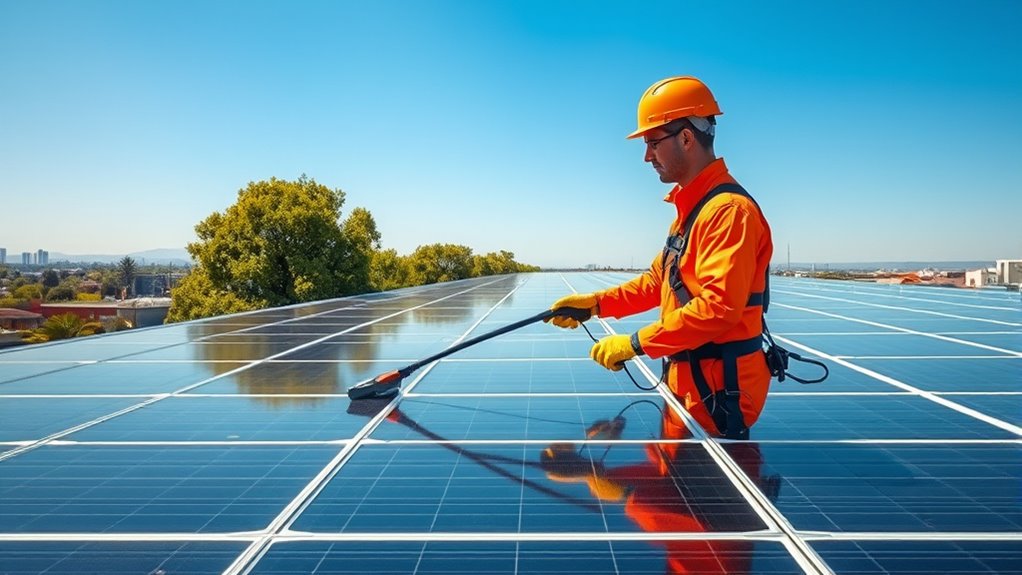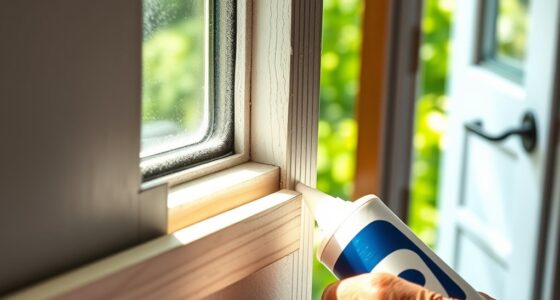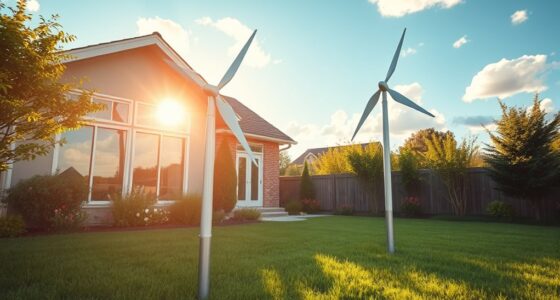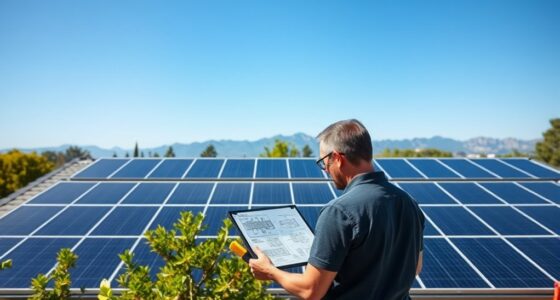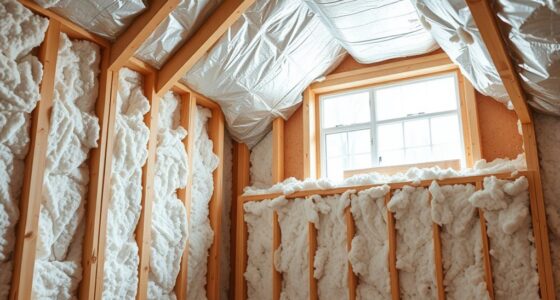To care for your solar panels, clean them at least twice a year using a soft brush or sponge with mild detergent, avoiding harsh chemicals. Perform inspections for cracks, damage, or debris, especially after storms, and make certain all parts are secure. Check your system’s performance regularly with monitoring tools and schedule professional checkups annually. Avoid cleaning during the hottest part of the day, and consider seasonal needs like snow removal. Continue with these practices to maximize efficiency.
Key Takeaways
- Clean panels 2-4 times annually using soft brushes and mild detergents, avoiding harsh chemicals or abrasive tools.
- Perform inspections for cracks, damage, and secure mounts, especially after severe weather events.
- Monitor system performance regularly with software to detect deviations and ensure optimal efficiency.
- Remove debris, leaves, and snow gently, avoiding thermal shock and damage, particularly during winter or storms.
- Schedule professional inspections annually to check electrical components, wiring, and system integrity.
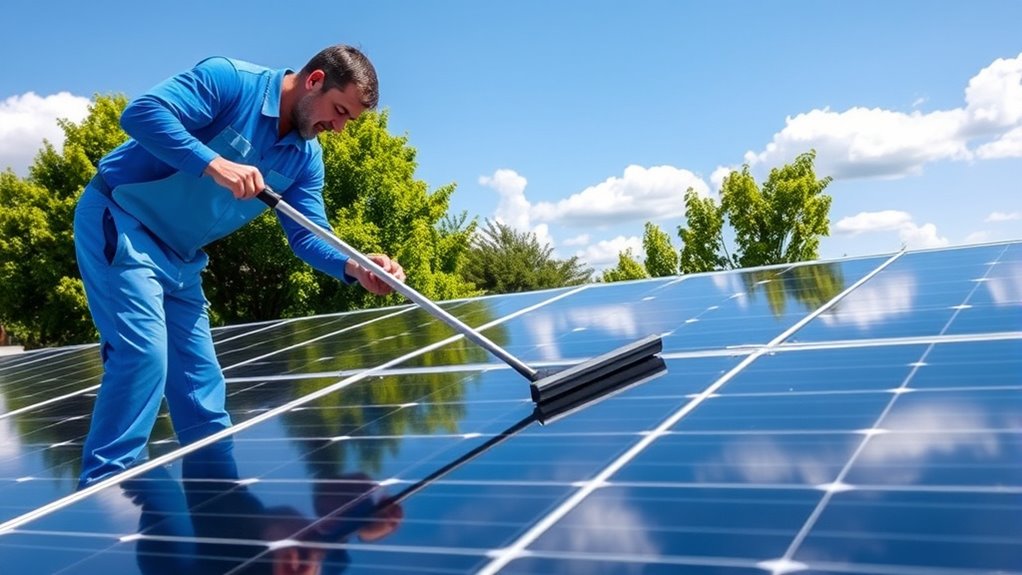
Are you maximizing your solar panels’ efficiency? Proper maintenance is key to guaranteeing your system performs at its best. Regular cleaning, inspections, and system checks help keep your panels functioning at their peak, preventing costly repairs and maximizing energy output over time. Solar companies generally recommend cleaning your panels at least twice a year, regardless of your weather or location. A good rule of thumb is to clean them two to four times annually for peak performance. It’s best to do this early in the morning or late in the afternoon when the panels are cooler. Cleaning panels during peak heat can cause thermal shock, which might crack the glass, and streaking is more likely if you clean them when they’re hot.
Maximize your solar efficiency with biannual cleaning, ideally during cooler parts of the day to prevent damage.
When cleaning, use soft-bristled brushes or sponges along with mild detergents—harsh chemicals or abrasive scrubbers can scratch or damage the surface. After washing, rinse thoroughly with clean water to remove any soap or detergent residues. Dirt, leaves, pollen, bird droppings, and dust can all obstruct sunlight, reducing your panels’ efficiency. Rainfall naturally rinses off some debris, but stubborn dirt or buildup underneath the panels often requires manual cleaning. Regularly removing debris helps guarantee sunlight reaches the solar cells without obstruction. Also, clearing debris from beneath the panels prevents animals from nesting or causing damage. Installing critter guards can further deter animals from nesting under your panels, especially if debris tends to accumulate. Maintaining optimal color accuracy in your system ensures the best possible energy conversion efficiency, as accurate calibration helps your panels perform as intended.
Performing frequent visual inspections is essential. Check for cracks, chips, or any physical damage, and look at the mounts, seals, and frames for signs of corrosion or wear. Make sure everything is secure and intact. Inspect wiring and electrical connections for corrosion or looseness—however, leave this to licensed professionals. Storms, hail, or heavy winds can cause damage, so inspecting your system after severe weather is vital. Confirm that your panels are mounted securely and that nearby shading objects haven’t developed, reducing sunlight exposure.
Monitoring your system’s performance is equally important. Keep an eye on your energy production using monitoring apps or software. Significant deviations from expected output can flag dirt buildup, shading, or electrical faults needing attention. Regularly check your inverter and ventilation to prevent overheating and efficiency loss. Annual professional checkups can catch issues early and guarantee your system stays in top condition, preserving warranty coverage.
In colder climates with snow, gentle removal might be necessary during heavy snowfall, but avoid abrasive tools that could scratch the glass. After storms, inspect for debris, dirt, or damage caused by wind or hail. During dusty or pollen-heavy seasons, increase cleaning frequency to maintain efficiency. Always perform maintenance from the ground or a safe platform to avoid falls, and never clean panels when they’re hot. Use non-abrasive tools and gentle methods to protect your investment and keep your solar array running smoothly.
Frequently Asked Questions
How Often Should I Replace My Solar Panels?
You wonder how often to replace your solar panels. Typically, you won’t need to replace them before 20-25 years, as they usually last that long with proper care. Keep an eye on efficiency decline, physical damage, or inverter issues, which might signal it’s time for replacement. Regular maintenance and assessments can help you decide when upgrading to newer, more efficient panels makes sense and saves you money long-term.
Can Snow or Ice Damage My Solar Array?
Snow and ice can damage your solar array if they cause water to freeze and expand, cracking panels, or if falling ice damages the surface. Heavy snow or ice buildup may also add weight, but quality panels are designed to withstand winter loads. Proper installation, regular inspections, and removing heavy snow or ice can prevent damage. Once snow melts, your panels typically recover their efficiency without lasting harm.
What Is the Best Time of Year for Maintenance?
Think of your solar panels as a garden that needs seasonal tending. The best time for maintenance is during spring and fall—like planting and harvest seasons—when debris and dirt accumulate. You should clean them at least twice a year, avoiding extreme weather. Regular checks guarantee your panels stay healthy, soaking up sunlight like a well-tended garden, so your energy flow remains strong year-round.
Do I Need Professional Help for Cleaning My Panels?
You might wonder if you need professional help cleaning your panels. If your panels are hard to reach, heavily soiled, or have stubborn grime, hiring experts is a smart choice. They have the right tools, safety training, and experience to clean thoroughly without damaging your system. Plus, professionals can spot potential issues early, helping you maintain peak efficiency and extend your panels’ lifespan.
How Do Weather Events Affect Solar Panel Performance?
Weather events can considerably impact your solar panel performance. Extreme heat, like heatwaves, reduces efficiency, while cloud cover decreases energy output, sometimes by up to 40%. Hail, snow, and ice can physically damage or block sunlight, lowering production. High humidity and moisture may cause corrosion, and flooding can harm electrical components. Regular inspections and prompt cleaning after weather events help keep your panels running efficiently despite these challenges.
Conclusion
To keep your solar array shining bright, a gentle touch now and then goes a long way. Regular care helps prevent minor issues from growing into bigger concerns, ensuring your system stays at its best. Think of it as tending a delicate garden—your attention nurtures its health and longevity. With just a little effort, you’ll enjoy the warm glow of reliable, clean energy for years to come. Keep up the good work, and your solar investment will thank you.

